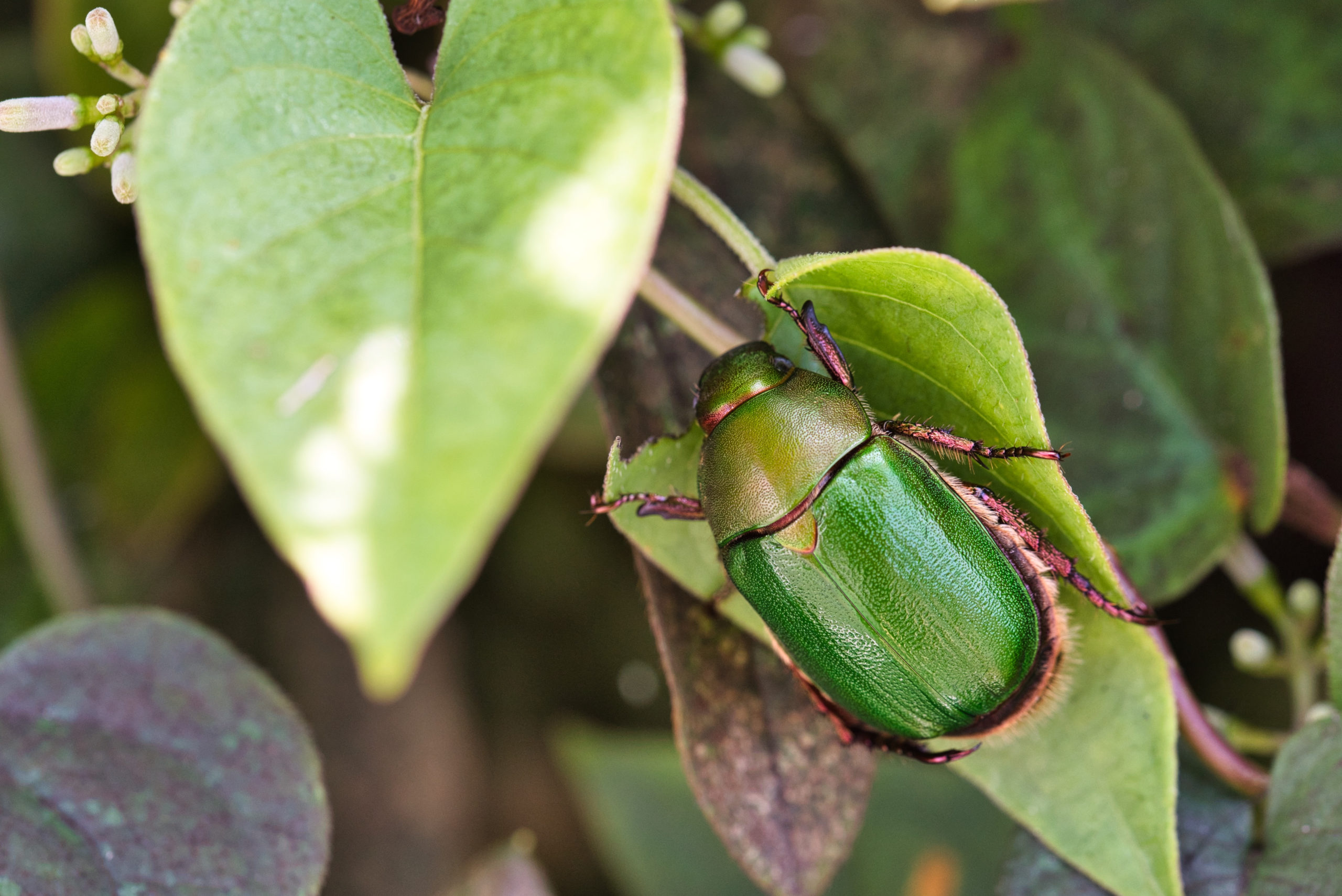The Shiny World of Green June Beetles
The Shiny World of Green June Beetles
Some pests, destructive as they are, are fun to look at. Their spots, stripes, vivid coloring, or detailed wings cause us to stop and watch them in action, especially if we have no idea what they are or what they do. Gardeners all the way from the Midwest to the East have plenty of experience with a particular bright green beetle. The metallic green coloring causes new finders of this pest to stop and wonder what in the world this shiny bug could be. Well, look no further for the answer: it’s likely the green June beetle! This famous garden pest causes headaches for fruit gardeners everywhere, so let’s look into the green June beetle’s life and how they seem to come back in larger numbers every summer.
The Life of a Green June Beetle

While this beetle is famous for its metallic emerald sheen, it can also be brown with green stripes. The green coloring stretches under the wings so the beetle can remain camouflaged with greenery while in flight. Talk about a useful design! Green June beetles are one to two inches long as adults, which is uncomfortably large for a garden pest. The reason for their abundance in summer is because they come out to mate in July and August. The eggs are laid in damp soil in autumn, and the hatched larvae will eat decaying organic matter until they overwinter and emerge as adults in the spring. Even though there is only one new generation of green June beetles born every year, it feels like far more because of this efficient natural way of life.
The grub stage of green June beetles is well-known due to their busy and destructive lives. The white grubs tunnel through soil searching for food, and often uproot young plants along the way. Any adverse weather or tilling of the soil may cause the grubs to be removed from their intricate tunnels, which is why it’s possible to find some on the concrete or in the garage. If you get the chance to watch the white grubs moving around, you may notice something strange about them. The grubs crawl around just like any other young insect, but they actually move on their backs! It’s unclear why they do this, but it is quite the sight when they decide to move around.
Adult green June beetles are excellent fliers due to their strong wings and large size, so they can move quickly between plants. They also tend to only fly low, which may be because they live in the soil and near plants when they’re not airborne. If you have seen green June beetles fly, you may notice another strange detail about them. They have a very bee-like buzzing sound that happens anytime they fly around, which can throw potential predators off since they don’t want to get near a stinging insect. This may just be the unintentional result of the beetles’ wings hitting their abdomen at a rapid rate, or it’s a brilliant defense tactic that they use to preserve their lives for at least another day of consuming our gardens.
An Abundant Diet

If we were to list every single item that green June beetles eat, this would be an essay. In short, they are drawn to very ripe fruit and aromatic organic matter. Fruit is the popular choice in gardens, much to the chagrin of the average gardener. Green June beetles are equipped with a small horn that they use to pierce the overripe fruit, then eat the delicious insides. They might eat a little bit of the fruit, or a few of them might team up to consume an entire nectarine. But since any fruit they touch is tainted with their odorous bacteria, it’s never a good thing when green June beetles find your fruit trees. Some of the favorite fruits of green June beetles include peaches, figs, raspberries, apples, nectarines, pears, plums, and grapes. These fruits all easily get soft and fragrant when overripe, which makes sense for the preferences of the beetle.
Adult green June beetles also eat compost and organic trash, which explains the gross smell on them. If you have a compost pile in the backyard, you may see a lot of them in addition to the other pests that love it. Green June beetles will even eat tree sap if it’s available, and seem to like maple or oak the best. The diet of the grub stage is less glamorous (yes, even more than compost), since they eat decaying matter that they run into while crafting their tunnels in the soil. Anything organic with a lot of nutrients is appealing to the green June beetle, just like many pests, and this becomes a major problem when their daily buffet happens to be our wonderful greenery.
It’s Not Easy Being Green

So, with all of these green June beetle facts in mind, how on Earth are there so many of them every year? We touched on the answer earlier, and it is basically the fact that they can overwinter. Any pest that is capable of surviving cold winters is given a natural head-start on the next year, population-wise. The larvae stage overwinters, and they are set up for success as newly-hatched eggs that consume soil and its nutrients. The larvae that become adults in the spring are then ready to produce the next generation of green June beetles in the late summer and begin the process all over again.
The good news about these pests is that they only harm crops, not people. They won’t bite or sting us, and would rather fly away when disturbed. But this is a small consolation for those who have an extensive garden or fruitful field. Green June beetles are one of the most harmful garden pests, and are a major headache for anyone with fruit trees. There are multiple problems that arise just from their diet alone. The most obvious is that they eat our fruit and the soil of our plants! If a group of green June beetles consumes a couple of plums, that’s two less plums that we get to enjoy. Plus, soil is the vital source of nutrients for plants, so if the nutrients and “good stuff” of the soil are eaten by beetle grubs, the plants don’t have the minerals they need. This can gradually kill the plants or lawn if it goes on too long without treatment.
Treatment Options

If you are an avid gardener or a lover of lawn care, you might be concerned for your plants after reading about these greedy pests. It is usually easiest to find and treat the pests in late summer when they are closer to the surface of the soil. There are a couple of natural ways to find and treat the pest problem. One is to find them by digging up some soil. It won’t be fun to dig up part of the lawn or landscaping, but it will be worth it if you find some hidden beetles because of it. If you think you have a green June beetle problem, dig up a few inches of soil in the affected area. You will know that there is a problem if you see a bunch of small white grubs nestled in the soil.
The next step is treatment. If you find a lot of grubs near the surface, you can till the soil until the grubs are more surface-level. You could then get rid of the grubs, or you can wait for the circle of life to take place and natural predators to find the grubs first. Birds in particular love grubs and worms, so they will be looking for a tasty treat in the area. Green June beetles are more common in very organic soil in general, so you may experience more of them if this is the case with your yard.
If you are still having issues with these beetles, or with other garden-dwelling pests in general, pest control services is always a great option. Our experienced technicians only use eco-friendly treatments that will eradicate the pests without damaging your plants and garden. We are always available to solve your garden pest problems! Contact us to learn more about our services and how we can make sure that the only green you see in your yard is your beautiful collection of plants.
Citations
Baker, J. (2021, July 15). Green June beetle in the landscape. NC State Extension. Available at https://content.ces.ncsu.edu/green-june-beetle-1 (Accessed on July 14, 2022).
Green June beetle (Cotinus nitida). (n.d.). Insect Identification. Retrieved on July 14, 2022, from https://www.insectidentification.org/insect-description.php?identification=Green-June-Beetle
Green June beetle. (n.d.). OSU Extension. Retrieved July 14, 2022, from https://extension.okstate.edu/programs/digital-diagnostics/insects-and-arthropods/green-june-beetle-cotinis-nitida/index.html?Forwared=entoweb.okstate.edu/ddd/insects/greenjunebeetle.htm
Lipford, D. (n.d.). Attack of the green June beetles. Today’s Homeowner. Available at https://todayshomeowner.com/attack-of-the-green-june-beetles/ (Accessed on July 14, 2022)
8 Creative Ways to Have a Pest-Free Fourth of July
8 Creative Ways to Have a Pest-Free Fourth of July 8 Creative Ways to Have a Pest-Free Fourth of July Summary: The Fourth [...]
A Simple Guide to Preventing Stinging Pests
A Simple Guide to Preventing Stinging Pests A Simple Guide to Preventing Stinging Pests Summary: Stinging insects are more active in warm weather, [...]
These 10 Natural Mosquito Repellents Can Actually Help
These 10 Natural Mosquito Repellents Can Actually Help These 10 Natural Mosquito Repellents Can Actually Help Summary: Natural mosquito repellents are easier to [...]
How to Get Rid of Carpet Beetles
How to Get Rid of Carpet Beetles How to Get Rid of Carpet Beetles Summary: Carpet beetles are sneaky pests that don’t usually [...]
How Do Roaches Affect Asthma and Allergies?
How Do Roaches Affect Asthma and Allergies? How Do Roaches Affect Asthma and Allergies? Summary: It’s no secret that pests impact human health, [...]
These 5 Carnivorous Pests Might Surprise You!
These 5 Carnivorous Pests Might Surprise You! These 5 Carnivorous Pests Might Surprise You! Summary: There are many eco-friendly ways to prevent pests, [...]

